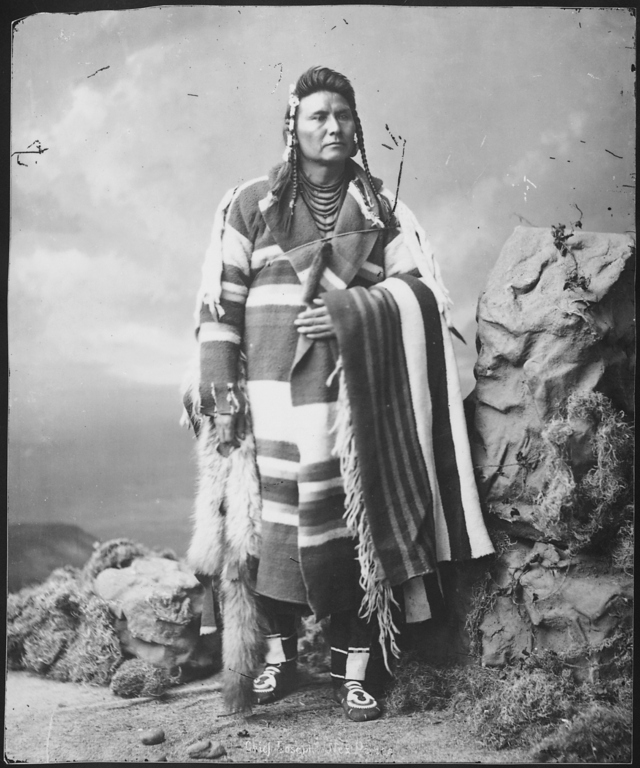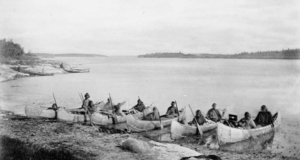The Use of Violence on the American Frontiers: Examining U.S.-Native American Relations in the 18th and 19th Centuries
By
2016, Vol. 8 No. 11 | pg. 1/2 | »
IN THIS ARTICLE
KEYWORDS
Following the end of the American Revolutionary War of 1776 to 1783, the U.S. government adopted an aggressive and expansionistic policy towards Native Americans on its frontiers. From the closing years of the 18th century to the end of the 19th century, the U.S. continually relied on these policies to open up the western frontiers for settlement and colonization by American settlers and immigrants from Europe. Native American tribes that opposed the U.S., or unintentionally got in its way, were swiftly dealt with by the U.S. and forced onto reservations where they could be controlled. The history of Indian-American relations demonstrates a general lack of willingness on the part of Americans to understand and accept Native American cultures and traditions.1 Three cases will be examined to show this policy in action: the Northwest Indian War of 1785-95, the First Seminole War of 1817-1818 and finally, the Nez Percé War of 1877. These three conflicts are important because, while not directly related to each other, they each show how the U.S. has historically been prepared to use violence against Native Americans to further its own goals. Though the U.S. was able to settle land claims and disputes with Native Americans tribes on the frontiers with the use of non-violent diplomatic means, these case examples are evidence of how the U.S. was prepared to use violence and warfare in Native American-U.S. relations over the course of the late 18th century and the span of the 19th century. From the Northwest Indian War we can see how the U.S. used military force to subdue its western frontier and assert its authority in the region. By the end of the First Seminole War it became evident that the U.S.’s conflicts with Native American tribes could have an adverse impact on U.S. relations with neighbouring states, such as Great Britain and Spain, as a result of individualistic and opportunist generals that engaged aboriginals with zeal. The Nez Percé War shows us what happens when a native tribe, pushed to the edge, fought back against the U.S.’s aggressive policies relating to the acquisition of its land. In this regard the Nez Percé tribesmen are an interesting case study as they were deemed to be one of the U.S.’s closest aboriginal allies. Across the western frontier an axiom persisted that no Nez Percé tribesmen had ever killed a white person.2 Violence was repeatedly used to ensure U.S. westward expansion went along with as little impediment as possible. Through the use of violence America was able to achieve its ‘Manifest Destiny’ and spread from coast to coast. The Northwest Indian War (1785 - 1795)While the Northwest Indian War is considered to have begun in 1785, the Northwest region had been in conflict for hundreds of years prior to this date. Initially, it was the French and British that fought over control of the region but, with the end of the American Revolutionary War, the conflict soon revolved around the attempts by the British and Americans to control the region. Known as the “middle ground” or “divided ground,” the Northwest became a contested region where the U.S. attempted to assert its dominance over the region and where the British aided their Native American allies in their fight against U.S. settlers.3 To examine this conflict and its outcome, this section will be divided into three parts: a brief examination of the conflict; an examination of the Shawnee tribe and the difficulties they faced in the region prior to and during the conflict; and finally, an analysis of what the outcome of the conflict meant for all of the parties involved. By examining the Northwest conflict, we are able to learn about what future U.S. policies would be towards Native American tribes and the fate of tribes that fought against the U.S. and its ‘Manifest Destiny’. The Northwest Indian War was a direct result of the U.S. policies relating to the acquisition of land from Indian tribes in the region. During the American War of Independence, and the years following the war, the U.S. attempted to appropriate land for the use of American settlers. While this attempt was made by the Federal Government, which under Article IX of the Constitution had the “sole and exclusive right and power of regulating… the trade and managing of all affairs with Indians…,” the actions by states and land squatters to lay claim to these lands led to a deterioration in U.S.-Indian relations.4 To combat the expansion of the U.S., a coalition of Maumee Shawnees, Miamis, Wyandots, Delawares, and other Great Lake tribes came together and created a Confederacy to oppose the U.S.5 Together, these tribes led several raids into neighbouring U.S. territories. The early 1780’s was rife with these small-scale skirmishes as both sides attempted to defend their claims to the land and the homes that they had built for themselves. In 1786, Indian war parties launched raids into Kentucky to kill white settlers on a weekly basis, becoming a constant threat that led, in turn, to Kentuckians crossing into the Ohio region and killing Native Americans indiscriminately.6 While the U.S. government was unwilling to intervene in the conflict because of the cost it would incur and a belief that a “conciliatory system” was the most effective solution, 1790 saw U.S. policies towards the Northwest region change.7 The escalation in the skirmishes and rising death toll finally resulted in military action being used to subdue the native tribes. Although the Confederacy of native tribes was able to win several victories early on in the conflict, the Battle of Fallen Timbers in 1794 effectively ended the war in favour of the U.S. The failure of the British garrison in Fort Miami to intervene in the battle showed the aboriginal tribes of the Northwest that they were not going to get any effective support from the British and ultimately influenced them to negotiate a treaty with the U.S. for peace.8 To get a better understanding of the effect that U.S. expansion into the region had on the aboriginal tribes, an examination of the Shawnee tribe and their plight is in order. Known as “The Greatest Travellers in America” by scholars, due to their constant exodus away from the U.S.’s continual incursion westward, the Shawnee were one of the many tribes that fought the U.S. for supremacy of the Ohio region.9 While the Shawnee were not inherently aggressive towards the U.S., as noted by their history of continual exodus to the west of their homelands and their reticence towards the use of violence, the mass influx of settlers into the Ohio region forced the Shawnee to take up arms. They did this because they believed it was the only way to live peacefully outside the reach of the U.S.’s authority. In the years prior to 1785, a mass immigration of some 80,000 settlers into the Northwest brought the Shawnee into direct confrontation with the settlers who now occupied the lands they claimed.10 To defend their land, the Shawnee aligned themselves with other Native American tribes and created the Confederacy to combat the U.S. as a combined force. The main objective of this Confederacy was to gain recognition by the U.S. federal government of Native American ownership of lands north of the Ohio River.11 Two key events ultimately ended the Northwest Indian War: the Battle of Fallen Timbers and the Jay Treaty of June 25th, 1795. While the Battle of Fallen Timbers saw the Confederacy defeated militarily by the American forces, the Jay Treaty saw the British pull out of the northwest region and put an end to their support for native American tribes fighting against the U.S. This treaty resulted in the demoralization of the Native American tribesmen and led them to negotiate a peace treaty with the U.S.12 With the surrender of the native tribes, the U.S. began the partitioning process of the Northwest region. During the negotiations, the aboriginal tribes ceded all but the northwest corner of Ohio region to the U.S.13 These negotiations ended with the signing of the Treaty of Greenville, the last act before the war finally came to a resolute end. Besides ending the conflict the treaty placed several restrictive conditions on the former Confederacy members; including the forced expulsion of the Indians from their lands and the obligation that Native American land could only be sold to the U.S. federal government.14 Rather than face such a crushing defeat to the Indians’ cause for independence, many chiefs and aboriginals committed suicide.15 The First Seminole War (1817-1818)Starting out as an attempt to subdue Native American resistance to U.S. encroachment into the Florida frontier the First Seminole War became an international incident for the newly independent republic. While the U.S. had fought several wars with neighbouring aboriginal tribes up until this point, none threatened to bring the wrath of European powers down onto the U.S. as much as the First Seminole War. This situation was the result of the rebellious and unilateral actions taken by General Andrew Jackson and his decision to obtain Spanish Florida for the betterment of the United States. Known for his disdain of Native Americans that opposed U.S. interests, Jackson believed that the aboriginal communities in Florida needed to be controlled by, and forced to rely on, the U.S.16 Upon being given command to nullify the Seminole threat Jackson instead launched an invasion of Florida and ultimately paved the way for Florida’s future annexation by the U.S. As will be seen, the use of the pretext of neutralizing the Seminole threat to U.S. interests across its southern frontier ultimately allowed the U.S. to annex Florida and expand its domain, much to the detriment of the Seminole community. While the First Seminole War was largely the result of the outcome of the War of 1812 two events in the years following the conflict ultimately led to clashes on the Florida frontier. These were the destruction of Negro Fort, its name as a result of the freed slaves occupying the fort following the withdrawal of British forces from the Florida region, and the ransacking of the Seminole village of Fowl Town. Following the end of the War of 1812 many plantation owners and farmers were upset over the fact that a fort occupied by free slaves was only 60 miles from American territory. Plantation owners viewed the fort as both a direct insult that de-legitimized their authority over their plantations and a risk to their ability to control their slaves.17 Fed up with the situation, the newly appointed commander to the southern division, General Andrew Jackson, decided to take action to end the threat once and for all. Jackson sent an American expedition into Spanish Florida to lay siege to the fort. On July 27, 1816, a cannonball launched from one of the American gunboats ignited the major powder magazine in Fort Negro and leveled the entire fortress. Two-hundred and seventy of the three-hundred and fifty freed slaves within the fort were killed instantly with the majority of the remaining survivors dying soon after from their wounds.18 While the destruction of Fort Negro greatly upset the Seminole community in Florida, as they were seen as both friends and allies against U.S. expansion, it was the destruction of the Seminole village of Fowl Town that ultimately resulted in the aboriginal community preparation for and acceptance of war with the U.S. Following the destruction of Negro Fort, Seminole chief Neamathla of Fowl Town ambushed a U.S. supply boat and killed all of the crew and their family members. In November, 1817, Chief Neamathla sent word to the U.S. commander of Fort Scott, General Edmund Gaines, to stay away from the territory he claimed as belonging to the Seminole people. Incensed that he was being belittled by the Seminole chief, and that Neamathla’s tone was insolent, Gen. Gaines ordered a detachment of U.S. troops to enter Fowl Town and arrest Neamathla. Upon their arrival, the U.S. soldiers opened fire upon the populace and burned down the village.19 The destruction of Fowl Town resulted in war battles across the Florida frontier as Seminole raids into the south increased. From the outset of the war it became evident that Gen. Jackson’s goals for the war differed significantly from those established by the Monroe presidency, both in scope and priorities. On the orders of the new Secretary of War, John Calhoun, the U.S. army was only to pursue Seminole forces into Florida and not to engage Spanish posts or populated centers.20 To Gen. Jackson, this order seemed absurd and out of touch with the realities that he was facing on the ground.21 Instead, Jackson believed that Florida should be occupied until Spain relinquished the territory to the U.S. Following his own directive, Jackson ordered his troops to assault Seminole villages and Spanish posts across the region and, within a few months, was able to end his Florida campaign with the occupation of the principal Spanish centre in Florida, Pensacola. Following his unilateral occupation of Spanish Florida, along with arresting the Spanish governor and establishing a U.S. customs house in Pensacola, Jackson took leave of command due to failing health and headed back to the U.S. Upon his return Jackson submitted a full report justifying his actions.22 To President Monroe, Jackson’s campaign across Florida was an unmitigated catastrophe that threatened to put the U.S. into direct conflict with both the Spanish and British Empires. While the Spanish Crown was upset with the occupation of its territory, the British government was angered over the illegal is illegal execution of British citizens Alexander Arbuthnot and Robert Ambrister. Captured within Spanish Florida near Seminole enclaves, both men were charged with “exciting and stirring up the Creek Indians to war against the United States.” Without asking President Monroe how he should proceed, or even making him aware of the capture of the two British citizens, Jackson put Arbuthnot and Ambrister on trial and condemned them to be executed for their crimes.23 Angering these two powers over the course of his campaign, Jackson returned home to an uncertain future. While Jackson was viewed as a hero by the majority of Americans due to his accomplishments the Monroe presidency was more hesitant over welcoming the conquering general home with open arms. Many of Monroe’s cabinet members wanted to censure Jackson over his actions and see him punished for unilaterally annexing Spanish territory. Instead, at the behest of the Secretary of State John Quincy Adams, Monroe decided to support Jackson and honored him as a national hero.24 Though Monroe publicly supported Jackson he worked hard to distance his presidency from the actions carried out by Jackson. This middle-of-the road approach between fully supporting Jackson and reprimanding him for his actions resulted in the U.S. returning the Florida region to Spain. Ultimately, however, Jackson’s campaign into the region showed the Spanish how untenable their position in the region was and paved the way for the U.S. acquisition of the land in 1821. For the Seminole community in Florida, the war’s end had resulted in devastation across the region and the end of Seminole resistance towards the U.S., for the time being. Jackson’s trek across the Florida region was marked by the executions of Seminole and Red Stick chiefs who had opposed the U.S. and the burning of crops and razing of aboriginal villages. When Jackson entered the Seminole village of Miccosukee, the largest Seminole town in the region, he ordered the buildings to be razed and execution of Chief Kinache.25 The loss of their leaders and their homes resulted in the Seminoles becoming demoralized and refugees in their former homeland. Many looked to the Florida swamps for safety from Jackson’s men as he continued on his trek to St. Marks. The end of the First Seminole War resulted in the Seminole survivors being forcefully moved into reserves from where they could be controlled and monitored. The fate that the Seminole community faced was what many aboriginal communities had faced across the frontier as a result of the U.S.’ continual westward advance. Just like the Seminole tribe, and the many that came before them, the Nez Percé of the Pacific Northwest region faced the same fate in 1877.Continued on Next Page » Suggested Reading from Inquiries Journal
Inquiries Journal provides undergraduate and graduate students around the world a platform for the wide dissemination of academic work over a range of core disciplines. Representing the work of students from hundreds of institutions around the globe, Inquiries Journal's large database of academic articles is completely free. Learn more | Blog | Submit Latest in History |



















